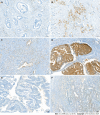Value of glucose transport protein 1 expression in detecting lymph node metastasis in patients with colorectal cancer
- PMID: 38414613
- PMCID: PMC10895641
- DOI: 10.12998/wjcc.v12.i5.931
Value of glucose transport protein 1 expression in detecting lymph node metastasis in patients with colorectal cancer
Abstract
Background: There are limited data on the use of glucose transport protein 1 (GLUT-1) expression as a biomarker for predicting lymph node metastasis in patients with colorectal cancer. GLUT-1 and GLUT-3, hexokinase (HK)-II, and hypoxia-induced factor (HIF)-1 expressions may be useful biomarkers for detecting primary tumors and lymph node metastasis when combined with fluorodeoxyglucose (FDG) uptake on positron emission tomography/computed tomography (PET/CT).
Aim: To evaluate GLUT-1, GLUT-3, HK-II, and HIF-1 expressions as biomarkers for detecting primary tumors and lymph node metastasis with 18F-FDG-PET/CT.
Methods: This retrospective study included 169 patients with colorectal cancer who underwent colectomy and preoperative 18F-FDG-PET/CT at Chungbuk National University Hospital between January 2009 and May 2012. Two tissue cores from the central and peripheral areas of the tumors were obtained and were examined by a dedicated pathologist, and the expressions of GLUT-1, GLUT-3, HK-II, and HIF-1 were determined using immunohistochemical staining. We analyzed the correlations among their expressions, various clinicopathological factors, and the maximum standardized uptake value (SUVmax) of PET/CT.
Results: GLUT-1 was found at the center or periphery of the tumors in 109 (64.5%) of the 169 patients. GLUT-1 positivity was significantly correlated with the SUVmax of the primary tumor and lymph nodes, regardless of the biopsy site (tumor center, P < 0.001 and P = 0.012; tumor periphery, P = 0.030 and P = 0.010, respectively). GLUT-1 positivity and negativity were associated with higher and lower sensitivities of PET/CT, respectively, for the detection of lymph node metastasis, regardless of the biopsy site. GLUT3, HK-II, and HIF-1 expressions were not significantly correlated with the SUVmax of the primary tumor and lymph nodes.
Conclusion: GLUT-1 expression was significantly correlated with the SUVmax of 18F-FDG-PET/CT for primary tumors and lymph nodes. Clinicians should consider GLUT-1 expression in preoperative endoscopic biopsy in interpreting PET/CT findings.
Keywords: 18F-FDG-PET-CT; Biomarker; Colorectal neoplasms; Glucose transporter type 1; Lymph node.
©The Author(s) 2024. Published by Baishideng Publishing Group Inc. All rights reserved.
Conflict of interest statement
Conflict-of-interest statement: The authors have no conflict of interest to declare regarding the publication of this work.
Figures


Similar articles
-
18F-fluorodeoxyglucose positron emission tomography/computed tomography and the relationship between fluorodeoxyglucose uptake and the expression of hypoxia-inducible factor-1α, glucose transporter-1 and vascular endothelial growth factor in thymic epithelial tumours.Eur J Cardiothorac Surg. 2013 Aug;44(2):e105-12. doi: 10.1093/ejcts/ezt263. Epub 2013 May 14. Eur J Cardiothorac Surg. 2013. PMID: 23674658
-
Comparison of GLUT-1, SGLT-1, and SGLT-2 expression in false-negative and true-positive lymph nodes during the 18F-FDG PET/CT mediastinal nodal staging of non-small cell lung cancer.Lung Cancer. 2018 Sep;123:30-35. doi: 10.1016/j.lungcan.2018.06.004. Epub 2018 Jun 9. Lung Cancer. 2018. PMID: 30089592
-
Comparison of 68Ga-DOTANOC and 18F-FDG PET-CT Scans in the Evaluation of Primary Tumors and Lymph Node Metastasis in Patients With Rectal Neuroendocrine Tumors.Front Endocrinol (Lausanne). 2021 Sep 1;12:727327. doi: 10.3389/fendo.2021.727327. eCollection 2021. Front Endocrinol (Lausanne). 2021. PMID: 34539577 Free PMC article.
-
18F-FDG PET/CT findings in endometrial cancer patients: the correlation between SUVmax and clinicopathologic features.J Med Assoc Thai. 2014 Feb;97 Suppl 2:S115-22. J Med Assoc Thai. 2014. PMID: 25518184
-
The clinical value of 18F-fluorodeoxyglucose uptake on positron emission tomography/computed tomography for predicting regional lymph node metastasis and non-curative surgery in primary gastric carcinoma.Korean J Gastroenterol. 2014 Dec;64(6):340-7. doi: 10.4166/kjg.2014.64.6.340. Korean J Gastroenterol. 2014. PMID: 25530585
Cited by
-
Scutellaria baicalensis and its flavonoids in the treatment of digestive system tumors.Front Pharmacol. 2024 Nov 25;15:1483785. doi: 10.3389/fphar.2024.1483785. eCollection 2024. Front Pharmacol. 2024. PMID: 39654621 Free PMC article. Review.
-
Reprogramming of Glucose Metabolism by Nanocarriers to Improve Cancer Immunotherapy: Recent Advances and Applications.Int J Nanomedicine. 2025 Apr 5;20:4201-4234. doi: 10.2147/IJN.S513207. eCollection 2025. Int J Nanomedicine. 2025. PMID: 40207307 Free PMC article. Review.
References
-
- Sung H, Ferlay J, Siegel RL, Laversanne M, Soerjomataram I, Jemal A, Bray F. Global Cancer Statistics 2020: GLOBOCAN Estimates of Incidence and Mortality Worldwide for 36 Cancers in 185 Countries. CA Cancer J Clin. 2021;71:209–249. - PubMed
-
- Al-Sukhni E, Milot L, Fruitman M, Beyene J, Victor JC, Schmocker S, Brown G, McLeod R, Kennedy E. Diagnostic accuracy of MRI for assessment of T category, lymph node metastases, and circumferential resection margin involvement in patients with rectal cancer: a systematic review and meta-analysis. Ann Surg Oncol. 2012;19:2212–2223. - PubMed
-
- Dighe S, Purkayastha S, Swift I, Tekkis PP, Darzi A, A'Hern R, Brown G. Diagnostic precision of CT in local staging of colon cancers: a meta-analysis. Clin Radiol. 2010;65:708–719. - PubMed
-
- Nasseri Y, Langenfeld SJ. Imaging for Colorectal Cancer. Surg Clin North Am. 2017;97:503–513. - PubMed
-
- Park IJ, Kim HC, Yu CS, Ryu MH, Chang HM, Kim JH, Ryu JS, Yeo JS, Kim JC. Efficacy of PET/CT in the accurate evaluation of primary colorectal carcinoma. Eur J Surg Oncol. 2006;32:941–947. - PubMed
LinkOut - more resources
Full Text Sources
Research Materials
Miscellaneous

